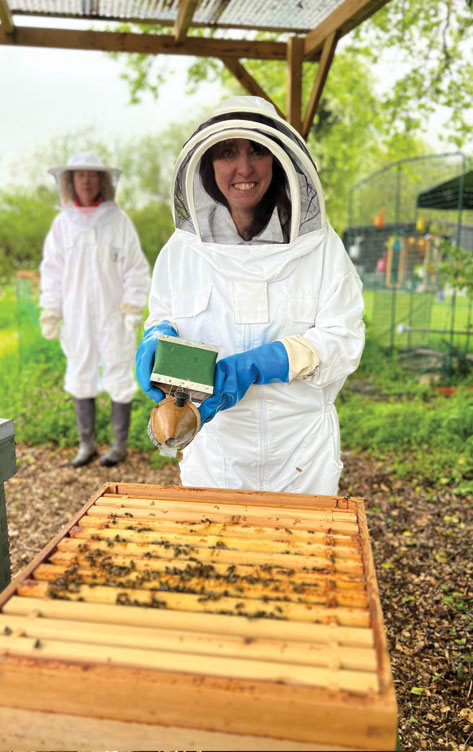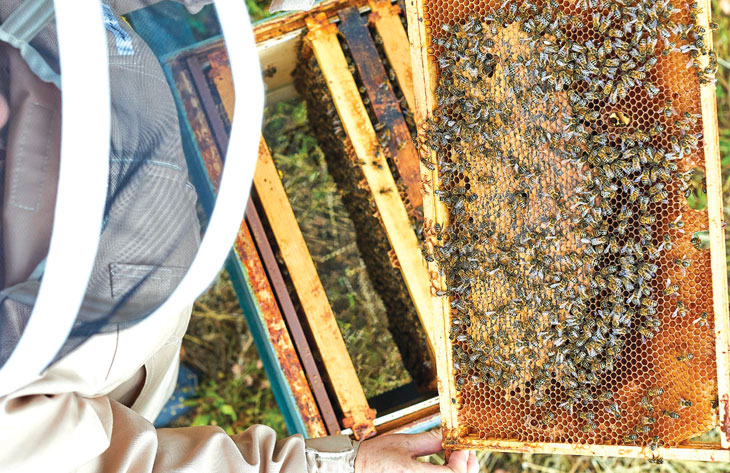Five years ago, Stacy Cronly-Dillon turned her back on corporate life and set up Sunnyfields Apiaries. Originally based in Essex but now located near Bungay, Suffolk, Stacy has 25 colonies of honeybees, each housing up to 45,000 bees. Hanneke Lambert went along to find out more.

I woke to a rather cold and rainy May day, but that didn’t deter me from discovering the world of the honeybee. Stacy offers an exclusive, up-close, and personal taster experience lasting two hours. It was just fascinating, and the session introduces a great insight into honeybees. Stacy’s extensive knowledge and passion for her bees really shines through. She lights up when she talks about bees, their history, purpose, and well-being.
Arriving at Sunnyfields Apiaries, Stacy turned the experience around and started with a chat over a cuppa and some baklava. She gave us three honey samples to try, one very light, the everyday sweet honey, through to a dark, rich honey. This was my personal favourite, as it wasn’t too sweet at all, and it had a thicker consistency.
With the rain cleared, Stacy decided it was safe to open a hive. Although it was too cold for Stacy to demonstrate the weight of each rack when full of honey and bees, we suited up. The suits were easy to put on, and Stacy checked us to make sure we were fully zipped up and secure! It certainly was a strange feeling, walking with a mesh in front of your face – you felt as though you were about to walk into something!
Stacy smoked the hive when she opened it, explaining that when bees sense danger, they release an alarm pheromone called isopentyl acetate from a gland near their stingers. The chemical travels through the air and alerts the other bees who get ready for attack! Smoking the hive masks that pheromone, allowing the beekeeper to open the hive and inspect it safely.

As Stacy opened the hive, the honeybees made a gentle hum that gradually grew louder as the bees became more aware of us ‘strangers’ around their hive. It really was something special to hear, although it was a strange feeling to have so many bees fly to your face and land on you. While instinct said to move away, I stayed still and calm and trusted Stacy and my suit! There were a couple of persistent bees that stayed in front of our faces. Stacy explained they were guard bees who are given this job for one day of their short life, and that they are searching for any signs of danger.
With the experience over, Stacy checked us over to make sure we didn’t have any bees still attached before we went back and got out of the suits.
To experience the bees in the hive like this really was special. I have always fancied the idea of keeping bees, but assumed it was a daily task and required a lot of time. However, Stacy explained that is not the case as, unlike keeping other animals, honeybees largely look after themselves. Beekeeping requires small amounts of regular time with your bees.
Sunnyfields Apiaries offer both group and private experiences, with prices starting from £65. Stacy also offers corporate days, making this a great way to bond as a team and get out into nature. In addition, Stacy offers training courses for those who fancy the idea of becoming a beekeeper.
• For full details, visit sunnyfieldshoney.com

the buzz
• The sound of the bees depends on both their mood and how they understand your mood. Bees have different temperaments, too, just as we do.
• There are around 20,000 species of bees around the world, with over 250 species in the UK alone.
• Not all bees produce honey: solitary bees – as their name suggests – like to live on their own, don’t have a queen, nor do they live in hives.
• Bee colonies are a hive of activity, pardon the pun; one queen, hundreds of male drones, and thousands of female workers make up a single average honeybee hive. Each bee performs a different role in order to ensure the smooth running and success of the colony.
• The role of a bee, as well as the season it was born in, is an important factor in the lifespan for worker bees in the colony. A queen can live up to five years while the average worker bee only lives for up to six weeks .
• Honeybees live in sophisticated colonies – superorganisms comprising up to 50,000 to 60,000 bees – and are mostly workers.
• Bees heat and cool their own hive, keeping it between 33°C and 35°C all year around. Bees are cold-blooded and must keep their hive at a constant temperature. In cold weather, they keep the hive warm by huddling together to generate body heat. They seal cracks in the hive with propolis, a resin-like material made from sap from any sticky tree or plant
• A single bee can produce 1/12th teaspoon of honey in its lifetime.
• A bee’s diet comprises honey and pollen – honey provides them with energy-laden carbohydrates, while the pollen provides the protein which includes the amino acids
• The queen lavae is fed extra royal jelly. The royal jelly is produced from the glands of the bees and is essentially a bee milk. She is given a greater quantity of royal jelly than worker and drone bees are given, this, along with the additional cell space as she develops, allows her to undergo changes which make her into a queen bee and not an average worker bee.
• Bees are remarkably tidy and very meticulous. They groom each other and keep their hive incredibly clean.
• The hexagonal shape of the honeycomb is the most efficient shape in our world. The pattern allows for the cells to be packed with no empty space in between. Though the wax is thin and delicate. The structure of the hexagonal cells can hold a tremendous amount of weight.
• Bees communicate by dancing, which could make the Monday morning meetings more interesting!
• Because of the high sugar content of honey, it is easily fermented into the alcoholic, honey-wine beverage known as mead. Mead, in its most simple form, is made from honey and water.










